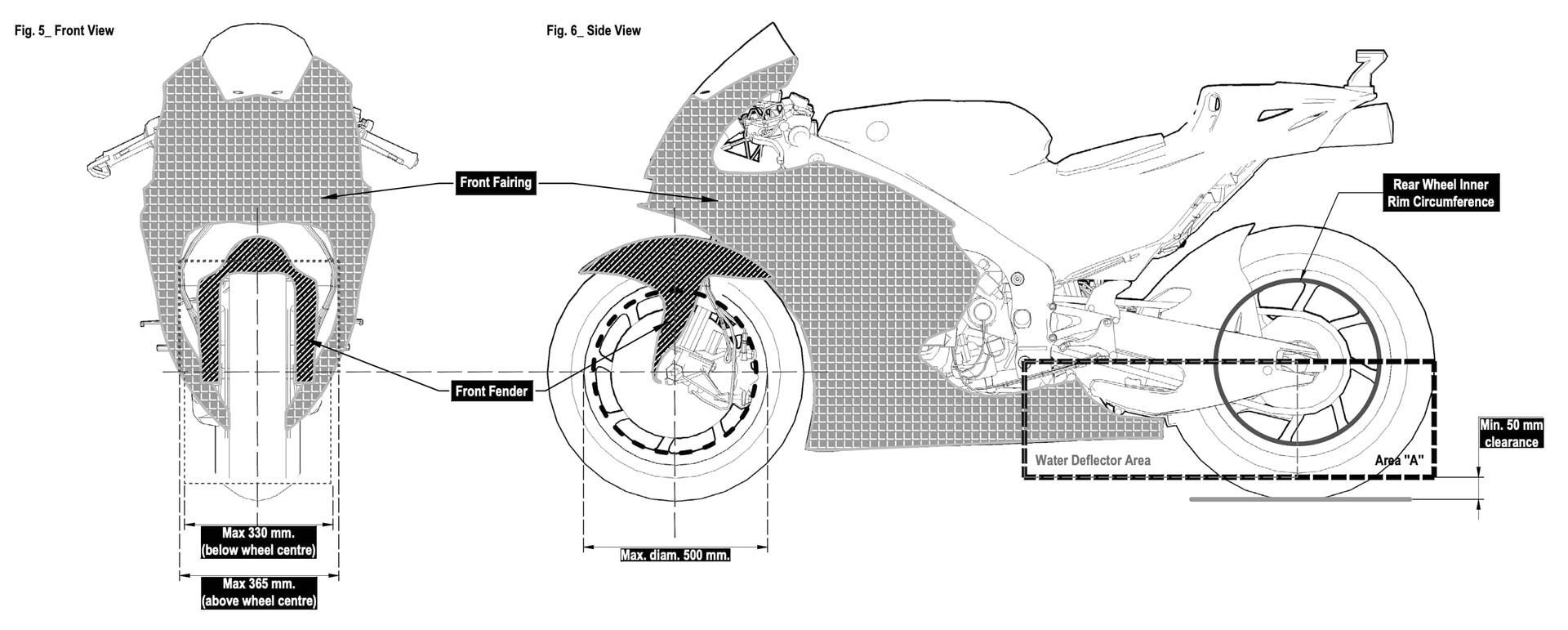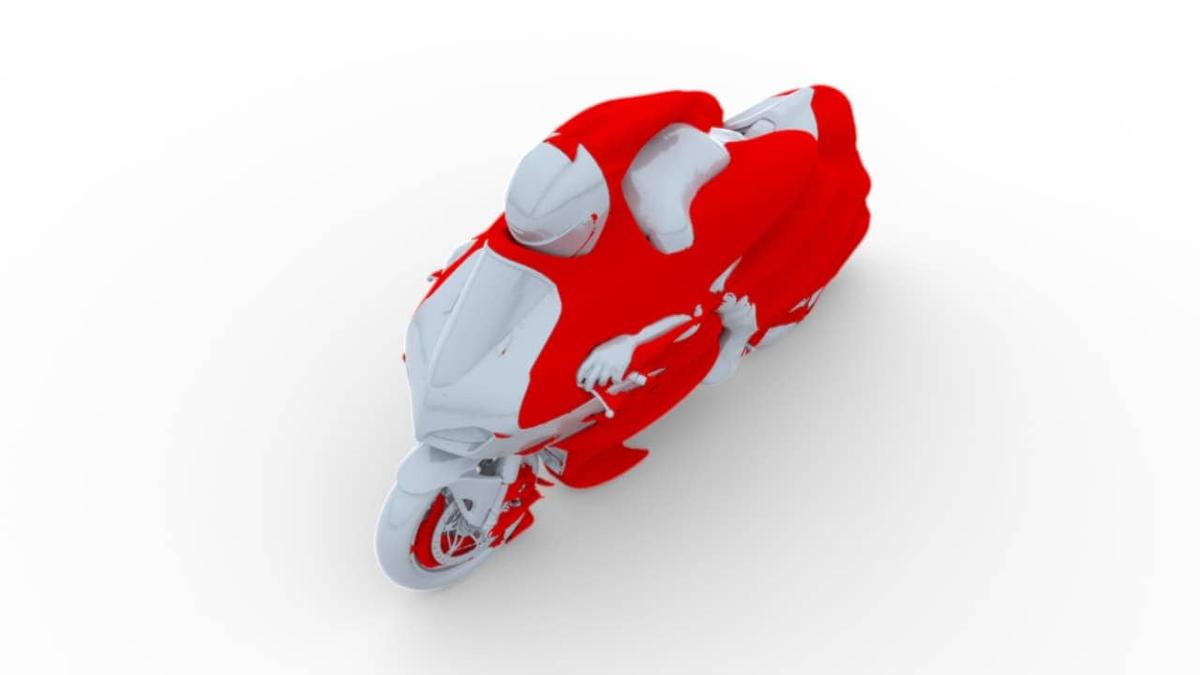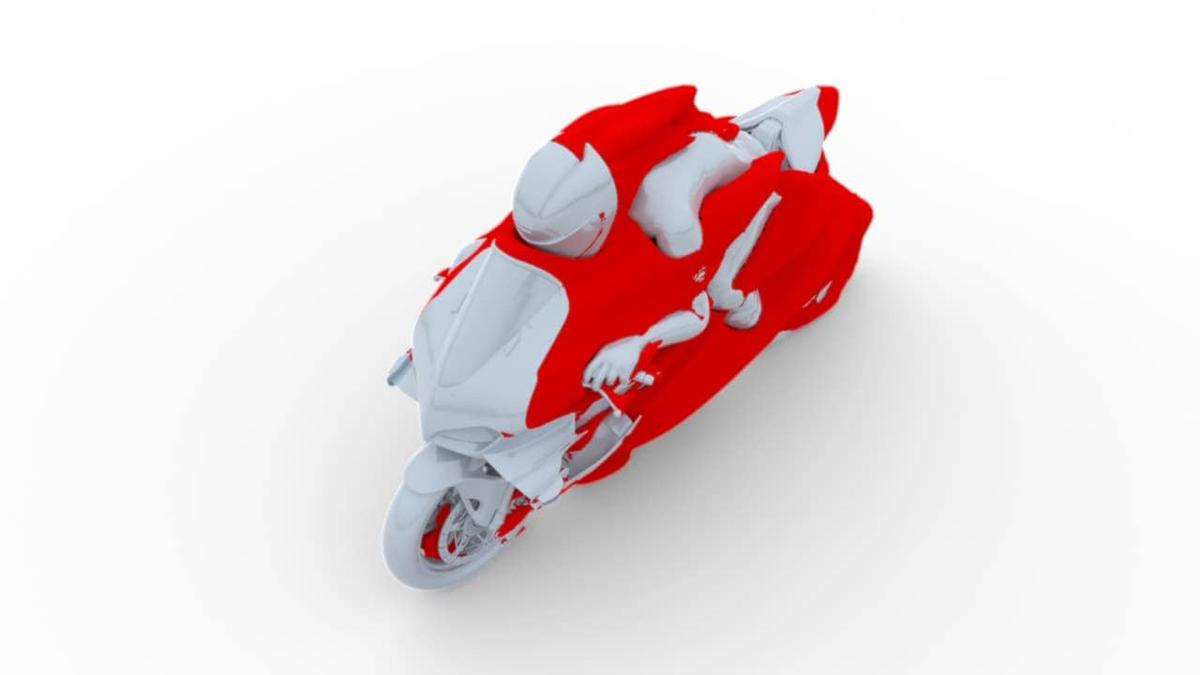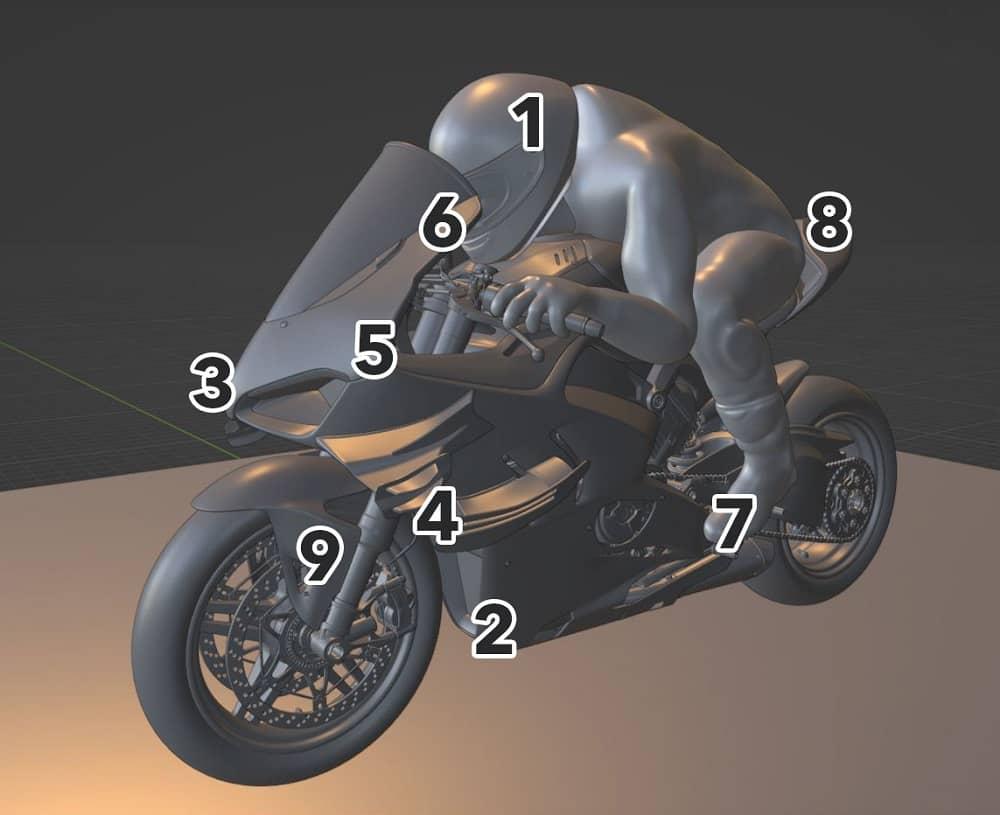Introduction
After the massive success of the Voyager-AirShaper F1 Challenge we are back for more with the "Dotto Creations -- AirShaper MotoGP Challenge"! Once again, we're looking at you, the community, to help us improve the aerodynamics of our virtual MotoGP Bike in this open project. As before, we'll turn the results into highly insightful, technical videos.
This time, we teamed up with Dotto Creations, a group talented creatives with roots at Pininfarina, Italdesign, Granstudio and Volvo Group. They started off with a public model of the Ducati Superleggera V4 and fitted a public model of a rider on top of it. So were are basicallly starting from a street legal bike to enter the virtual MotoGP championship and will step by step improve the performance. Perfect? No. Compliant with MotoGP rules? Probably not. Close enough to reality and more than good enough to study & improve MotoGP aerodynamics, gain insights, start another vibrant community project? Oh yeah!
Once again, we will not impose strict rules for this challenge, to allow for a broader audience to participate. But for those who do wish to study the regulations and suggest design solutions which comply with the rules – please do, it only adds to the thrill of our virtual challenge! Especially figures 1 to 6 on the general dimensions & aero body definition are interesting! But do dig deeper yourself 😊


Reference
For this challenge, we chose to work with Regular simulations, as the 10 million cells combined with our adaptive mesh refinement seem to capture the details quite well. At some point, we may run a 50-100 million Advanced Simulation as a benchmark, but the current approach is more accessible for people to download & open the data on their own machines if they wish to process the results in Paraview.
We ran simulations on both the standard bike and the one with a first shot at the aerodynamic elements.
| Standard bike | Aero bike |
|---|---|
 |  |
| Frontal surface area A:0.567m² | Frontal surface area A:0.581m² |
| Drag force: 396N | Drag force: 470N |
| Drag coefficient Cd: 0.454 | Drag coefficient Cd: 0.526 |
| Lift coefficient Cl: 0.0 | Lift coefficient Cl: -0.211 |
| Front lift coefficient Cl(f) : 0.143 | Front lift coefficient Cl(f) : 0.01 |
| Rear lift coefficient Cl(r): -0.143 | Rear lift coefficient Cl(r): -0.221 |
| Download 3D model | Download 3D model |
| Download Report | Download report |
| View online results | View online results |
| Download simulation data | Download simulation data |
Analyzing data
There is a lot to learn already from these 2 simulations:
-
The drag coefficient of a motorbike in general (0.40-0.60?), is really high compared to modern cars (0.20-0.30). It simply is a very complex geometry with a lot of sharp edges, components sticking out, rider changing position, separated flow etc.
-
The frontal surface however (around 0.6m²) is smaller than that of cars (1.5-3.0m²) and thus the total drag (or CdA) ends up in the same range.
-
The net vertical force may be close to zero on the standard bike (Cl of 0.006) but the individual forces on the front & rear wheel differ a lot: a lot of lift at the front (Cl(f) of 0.143) and a lot of downforce at the rear (Cl(r) of -0.143). This is largely due to the fact that the "center of pressure" is quite high above the ground, meaning that the aerodynamic drag will push & tilt the rider and bike backward. This tends to lift the front wheel off the ground and push the rear wheel down onto the ground. As aerodynamic forces scale with the square of velocity, this effect becomes very important at high speeds.
-
When accelerating, you are again shifting the weight to the rear of the bike see this video! So it becomes quite clear why in racing, the goal is to generate downforce at the front to keep the front wheel down, increasing the maximum acceleration limit as well as increasing the grip limit of the front wheel;
-
The results of the Aero bike clearly show the potential of aerodynamic elements at the front: the front lift coefficient Cl(f) has dropped from 0.143 to -0.01. Interestingly, the rear lift coefficient has also dropped from -0.143 to -0.221.
To dive into the simulation data yourself, we suggest you to:
-
Go through the simulation reports for both bikes
-
Check the online visualizations, analyze the pressure clouds, move the streamlines around, zoom in on the friction map to spot separation etc.
-
Download the simulation data and do your own post-processing in paraview -- see this video.
Challenges
The bike does not comply with the official regulations and we don't intend to make it to. Nevertheless, the goal of this challenge is to come up with solutions that are realistic and stay close to the rules:
-
Don't simply increase the size of the wings, tuck the driver further down, ... . That's too easy -- no fun in that!
-
Focus on improving flow quality in critical areas. Spot areas of separation and understand why it happens.
-
If you have the time, please do go through the official MotoGP rules to support your suggestions.
This is an open challenge, meaning that all suggestions are welcome. Nevertheless, to make things more interesting, we've listed a few goals below.
Aero challenge #1 -- Plotting the acceleration graph
As discussed above, the aerodynamics have an influence on how fast a motorbike can accelerate. To get a feel for how big this effect is, we want to see a tool that plots this based on some key parameters of the bike (weight, power, Cd, Cl(f), Cl(r), wheelbase, CoG). Once we have this, we can plug new aero results into this method to see the effect on straight line performance!
Assumptions:
-
A friction coefficient of 1 (but make this dynamic if you want to play with the model).
-
A weight of 250kg for bike and rider (center of Gravity at 0.8m above the ground, in between front & rear wheel)
-
Wheelbase of 1.5m
-
A power output of 240HP (forget gears & power curves, just assume constant power).
-
Ignore mechanical resistance for now.
Tips:
-
Take small time increments and calculate the force balance for each one.
-
P = F * v. So the available acceleration force (for constant power) at the rear wheel equals P / v. Don't forget to subtract the required power to overcome aerodynamic drag!
-
Excel is your best friend, but you can go astray 😊
Aero challenge #2 -- Tilting the downforce vector An interesting aspect is how the downforce affects the cornering speeds: it helps to push the bike onto the ground, which increases the friction limit. But as the bike tilts, this downforce will also have a horizontal component, pushing the bike (and rider) out of the corner. Will downforce increase, decrease or not affect the cornering speed? Refresh your force vectoring skills and see if you can come up with an answer!
Aero challenge #3 -- Pushing down the front
The main goal for now is to gain more downforce at the front. Modify the front wing, play with the mirrors, change the wind screen, ... as you like, but do check the rules to see if your ideas are only mildly or completely crazy! We'll give preference to realistic ideas.
The front lift coefficient Cl(f) is now -0.01 -- let's aim to bring it down to at least -0.05! And yes, you'll have to be mindful not to destroy the drag in the process 😊
Sharing your ideas
To achieve this, we will use your input!
Just drop your thoughts on the AirShaper Reddit channel (use the flair "MotoGP Challenge"):
-
Analysis: drop your insights on where you think the flow can be improved. Support your insights with post-processing screenshots of the 3D viewer / paraview.
-
Suggestions: drop your sketches on how you think the 3D model should be modified.
-
3D model: if you want, you can also modify the 3D STL and/or Blender model directly.
We'll screen the Reddit channel regularly and gather design input. As soon as we have enough input, we will create an updated 3D model, run a simulation and share the results on the Reddit board!
Aero Update 1
A massive thanks to everyone in the community who contributed to this first aero update! In particular, thank you Luca & Andro for analysing the data and for sharing your suggestions and even 3D models for the updates. And a big thanks to Dotto Creations for implementing all of these suggestions into a new, sleek 3D model! Here is a short overview of the changes we implemented:

-
Improved helmet design: The original helmet featured a step-change in geometry at the rear. That is useful to fix the separation point to reduce buffetting loads, but bad for the transition of the flow onto the back of the rider. So the helmet was redesigned completely.
-
Better curvature around the bottom radiator: We observed flow separation around the side & bottom edges of the radiator inlets. So those edges were given larger rounds.
-
More rounded front, small spoiler in front of cooler: The nose was too sharp and was causing flow separation. The new design is more rounded.
-
Smoother fairing around the radiator: Same as point 2 - the edges around the sides were given larger rounds to reduce separation.
-
Small "jump" to cover hands: The front fairing was pulled outward a bit with the aim of making the air jump around the hands & handle bars.
-
Small "jump" to cover shoulders: Similarly, the front fairing & wind screen were modified to make the air jump across the shoulders of the rider.
-
foot support: remained unchanged
-
Rear wing added: A rear wing was added to generate downforce at the rear.
-
Improvements to the mudguard The front mudguard was modified slightly to clean up the airflow.
Aero Update 1 results
Interestingly, the drag of the bike had gone up by 0.6%! Downforce improved though by around 3%. Please see the video below for a highly detailed analysis & check the online results
Although the above trade-off would be good on a track with many corners, we're now trying to reduce drag by cleaning up the flow at the front of the bike and by removing the rear wing. Once we've managed to do so, we'll focus on the "downstream" part of the bike to regain some of the downforce.
Goals for aero update 2:
- Clean up the airflow at the front
- Remove the front wing
